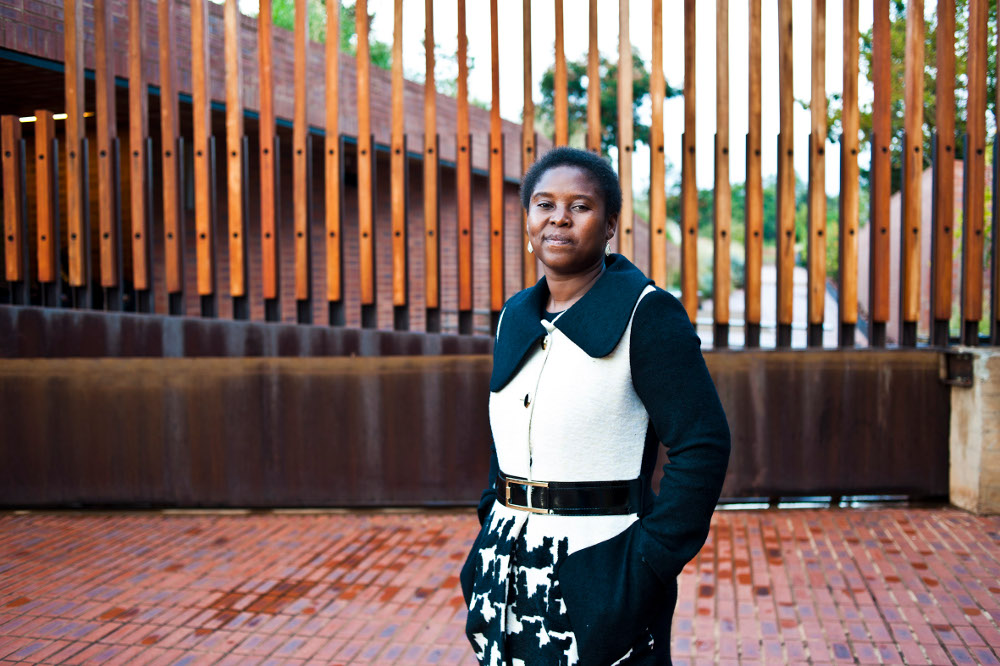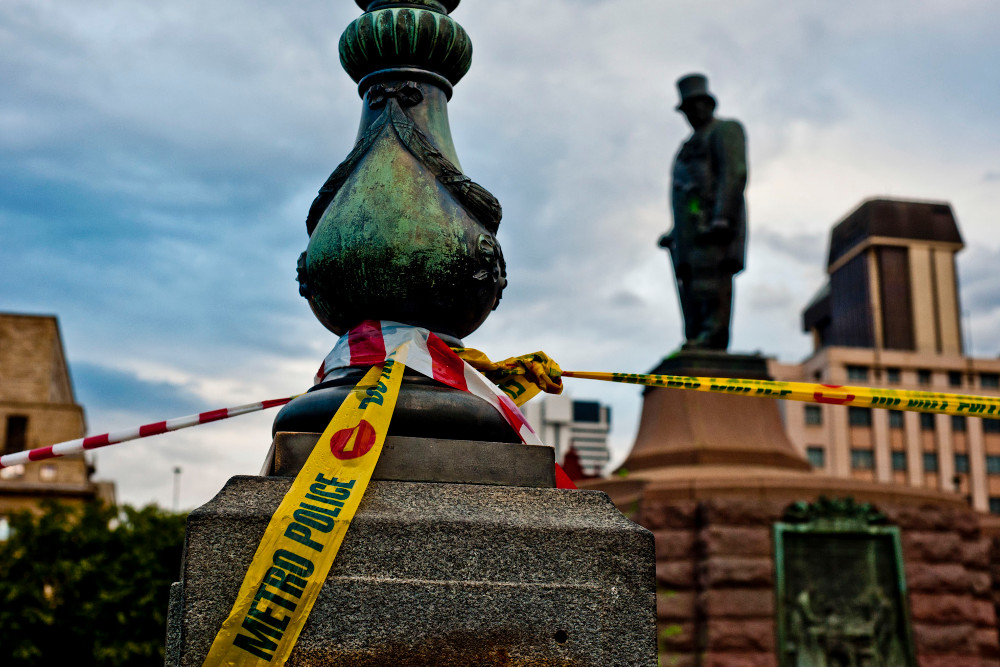The statue of Cecil John Rhodes is readied for its removal from UCT's campus.
NEWS ANALYSIS
“So this 24-hour protection thing is real?” a man, pausing briefly from his daily commute, says to a traffic cop buffing his boots on a pillar at Pretoria’s Church Square.
“Nahana, jo [Imagine, brother],” the cop responds, “and this is not even for a statue of Nelson Mandela, but for people who oppressed us.”
The traffic cop was part of an entourage knocking off from their day shift, to be replaced by others who would guard Boer president Paul Kruger’s statue through the night.
A row of five metro police vehicles formed a disjointed chain along the front of the statue. It was soon joined by a South African Police Services van. Police tape cordoned off the rest of the statue.
Earlier on Wednesday, Afrikaans singer and far-right-wing activist Sunette Bridges had chained herself to a stone Boer burgher at the bottom of the Kruger statue, blaming President Jacob Zuma’s utterances about Jan van Riebeeck for its defacement. Fellow right-winger and entertainer, Steve Hofmeyr, blamed it on illiteracy when he addressed a motley crowd of about 300 supporters.
Later that night, University of Cape Town students impatiently and triumphantly stormed a council meeting that voted for the removal of the statue of Cecil John Rhodes from its place of prominence on their campus. The offending statue was removed on Thursday.
Paint job
Earlier this week, members of the Economic Freedom Fighters claimed responsibility for splashing the statue of Paul Kruger and the burghers with green paint. They said their members had done it to commemorate the 36th anniversary of the execution of ANC guerrilla Solomon Mahlangu and in recognition of 363 years since Van Riebeeck’s arrival in the Cape – when South Africa’s problems began, as Zuma said. The EFF added that the defacements were 21 years too late.
For the ANC, it seemed the ruling party had suddenly awakened to the omnipresence of colonial figures in town squares, with Zizi Kodwa quipping on Kaya FM on Thursday: “You can imagine if you have a statue of Adolf Hitler in the middle of Tel Aviv’s city centre … you’re not just provoking the Jewish people, you’re igniting a war. Because they feel so offended about the Holocaust.”
Suggesting a path forward for the future of statues that celebrate colonial and apartheid leaders, he said: “You can’t obliterate history … they must be kept in a place of safety, in a museum.”

Jane Mufamadi says politicians are piggy-backing on the statue issue. (Delwyn Verasamy, M&G)
Jane Mufamadi, chief executive of Freedom Park, a museum that honours the fight for democracy in South Africa, said the country needed direction about where it was going with regard to monuments. “People have hijacked this statues issue,” she told the Mail & Guardian this week. “Students used Rhodes to voice their dissatisfaction around issues of transformation in the context of what was happening on their campuses. They pointed at symbols and traditions that showed nothing had changed.
“Off campuses, people are opportunistic. This is not about individuals. It’s about the principle of what we want as a nation. Whether or not [the statue of] Paul Kruger is an eyesore, the nation must decide. You don’t see people saying: ‘We approached the South African Heritage Resources Agency or the department of arts and culture [to institute a process for the statues to be removed] and they declined.’?”
Heritage issues
But with politicians across the spectrum and right-wing alarmists largely speaking into a vacuum, what is revealed is that South African heritage bodies, especially those responsible for policy development have been caught on the back foot.
And those who have to implement the policies that are in place, sense a lack of awareness among the general public about how to go about that.
“Unlike in other countries where there were scenes of triumphant cadres and people toppling down statues, we had a negotiated settlement, not a mass insurrection,” says the chief executive of the National Heritage Council, Sonwabile Mancotywa. The council, which was formed in 2004, is tasked with, among other things, advising the minister of arts and culture on heritage policy matters.
“That transition, with figures like Nelson Mandela and the government of national unity, is linked to the issue of why we still have those statues.
There has been a “policy vacuum” said Mancotywa. “The removal of statues has been ad hoc, as you saw in the Midvaal removal of the [Hendrik] Verwoerd bust. There was no consultation or public discourse and, in fact, that statue ended up in the hands of the community.”
Statue audit
Mancotywa says the council commissioned a study in 2010 after a flurry of defacements and controversies surrounding statues.
“A panel of experts looked at countries that went through a painful transition such as Hungary, Argentina, Mali and the old Soviet bloc … the consensus was to conduct an audit of statues representing a colonial past and decide on policy action … and decide on monuments that reflected the new South African order. [In Hungary], even when you remove the statue, you keep it in the garden of memorial, where it is properly contextualised in terms of its epoch.”

EFF members vandalised the statue of Paul Kruger in Pretoria’s Church Square. (Delwyn Verasamy, M&G)
South Africans needed to be taught their history because the history they were taught was distorted, he said. “The concept of destroying is dangerous. This is because history is written by the victors. We have a long way to go towards writing our own history.”
Asked why a study commissioned in 2010 was only revealing its policy recommendations at the end of this month, Mancotywa said among other things it had taken a while to get the buy-in of the arts and culture department.
Student struggle hijacked
Meanwhile, a number of students feel that the current debate, which has been seized on by political parties and bureaucrats, represents a hijacking of their struggle.
“While we appreciate the solidarity, the danger in linking with established structures such as the South African Students Congress and established political parties is that movements that grew out of organic concerns can be co-opted into existing structures,” said Rhodes University Black Students Movement member, Jonis Ghedi Alasow.
“Now it is marginalised people that are articulating their own struggles and they need to be left alone to do that. People talking for students have had their turn and yet we’re still dealing with issues that have been here since before 1994.”
Tshepo Moloi, a PhD candidate at the University of Johannesburg said: “We must realise there’s nothing post about post-coloniality. The tools of colonialism are what we need to address: they diminish mainstream activists and politicians into nothing but neocolonialists. What the students are showing them now is they never really had a programme.
“[EFF leaders] Floyd Shivambu and Mbuyiseni Ndlozi … were all at Wits. They were all in student leadership positions. Why did they not raise those issues then? Why is what these kids are doing now suddenly connecting to the national discourse? Now they [the EFF] are part of mainstream politics, a waste of time populated by people who talk but have nothing to say.”
Moving Rhodes may flout heritage protocols
A climate-controlled gallery and storage facility in the basement of the Voortrekker Monument outside Pretoria is where many of apartheid’s relics end up – to rest in peace and not in pieces. This statue graveyard is the headquarters of the Erfenisstigting (Heritage Foundation), a section 21 company founded in 2002 that until recently was funded by the National Lotteries Board.
Anyone intending to move a provincial statue – such as the Troepie statue of a South African Defence Force soldier, located at nearby Fort Klapperkop – would first need to secure the approval of a provincial heritage resources agency.
To kick-start the removal, one would have to initiate a process of public participation, which would include advertisements in local newspapers, as well as notices at the statue’s current site and at the site of the intended relocation.
The public participation process should last at least 60 days, according to South African Heritage Resources Agency regulations. Meetings with concerned and affected parties should be conducted within this period.
“In the case of Cecil John Rhodes,” says Sonja Lombard, managing director of the Erfenisstigting, “it would include the Mandela Rhodes Foundation and relatives overseas.”
Only once a provincial heritage resources agency is satisfied that public participation requirements have been fulfilled will it issue a permit for the statue’s removal. To apply for the permit one would have to complete forms on the heritage agency’s website, proving that the requirements have been met.
“With the University of Cape Town decision [to remove the statue of Rhodes], I haven’t seen any adverts for public participation in the newspapers,” says Cecilia Kruger, senior manager of heritage conservation at the foundation.
Students and lecturers have been discussing the issue for weeks, but she insists that 60 days have not elapsed since the #RhodesMustFall campaign started.
“We’d like to join the public participation on the Rhodes statue [debate] as well, as we are an interested party. It is our mandate, after all, to conserve heritage.”